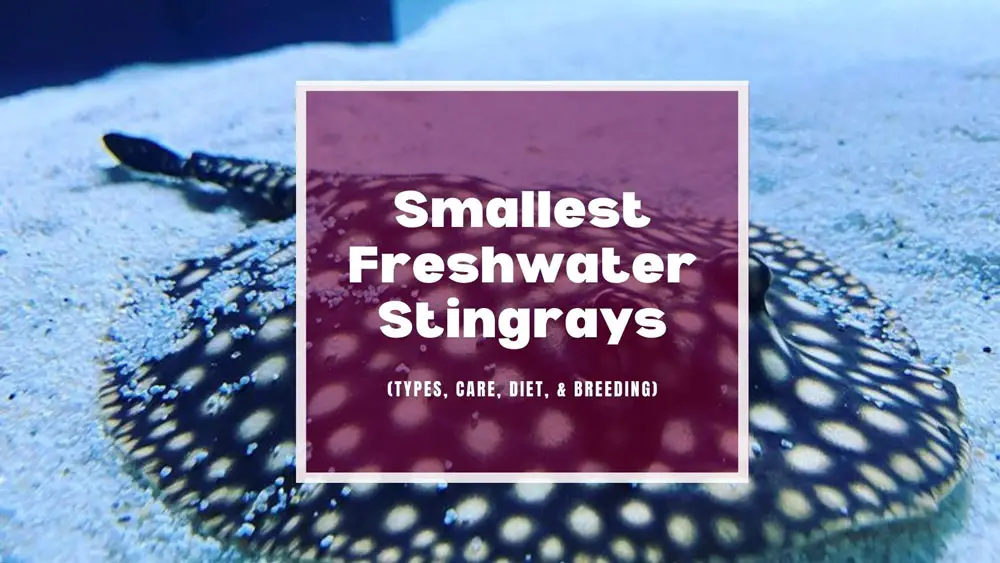When most people think of stingrays, they think of the large, dangerous ocean predators. However, there are also many freshwater stingrays that are found in rivers all over the world. These species are often much smaller than their ocean counterparts and are not known to be extremely dangerous to humans.
However, one reason freshwater stingrays turn most fish keepers away is their large size.
That’s right, most of these ancient fish can easily reach lengths of over 20 inches (50cm), not including their tails.
Luckily, here are a few small freshwater stingrays species that can be kept in a home aquarium. These unique fish are very intelligent and enjoy interacting with humans. That said, you can even try to hand feeding them through training.
In today’s article, we cover a list of the smallest freshwater stingray in the trade and their habitat requirements, diet, tank mates, and much more!
Fun Facts About Freshwater Stingray
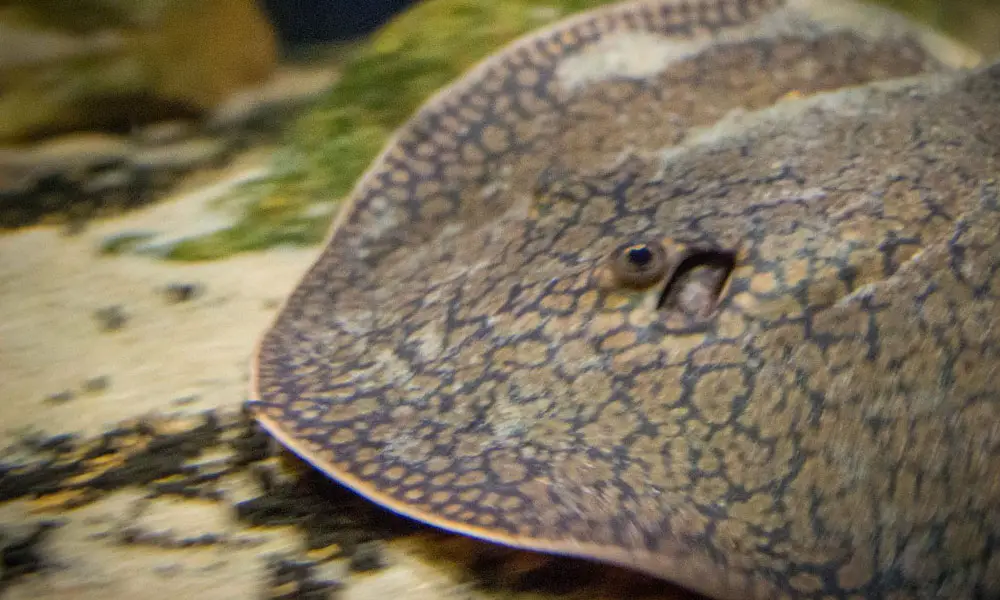
Before we get into the list, let’s learn a little more about these amazing creatures.
- Stingrays are actually related to sharks. It’s true! Stingrays, along with sawfish, skates, and guitarfish, are classified as elasmobranchs, a group of animals with cartilaginous skeletons rather than true bones.
- Their bodies are supported by a network of connective tissue and cartilage – the same tissue you feel at your nose’s tip.
- Despite the identical body shapes, their rays are quite different from one species to another.
- Stingrays have venomous spines on their tails, which are used to protect themselves. Contrary to popular belief, these spines are not used to attack prey.
- Freshwater stingrays are peaceful species, and they would not come at you with their spines unless they are being harassed seriously. Be aware their stings are dangerous to humans. It is said that the pain from a stingray’s spine can be as bad as that caused by a piranha.
- Freshwater stingrays most seen in the aquarium trade come from Potamotrygon – a genus of more than 30 described species, only found in river systems in South America.
- Today, freshwater stingrays sold in the trade are captive bred. Not only are they more likely to be healthy, but they are also more acclimated to life in captivity.
Dangers and Restrictions of Owning Freshwater Stingray
With stingrays, there are a few things you need to know before you decide to get one.
The first and most important danger is that their barbs are venomous. If you are stung by a stingray, it will hurt—a lot. If you are stung, press the affected area with a heated object, sterilize it and seek immediate medical attention.
Another thing to consider is that it is illegal to own a stingray as a pet in some states and countries since it is considered an exotic species. Releasing them into the wild can cause problems for local ecosystems. Of course, you should never release an unwanted fish or animal into the wild.
The 3 Most Popular Small Freshwater Stingrays
Now that we know a little more about freshwater stingrays. Let’s get into the list of the smallest species that can be kept in home aquariums.
The Smallest: Teacup Stingray (Potamotrygon magdalenae)
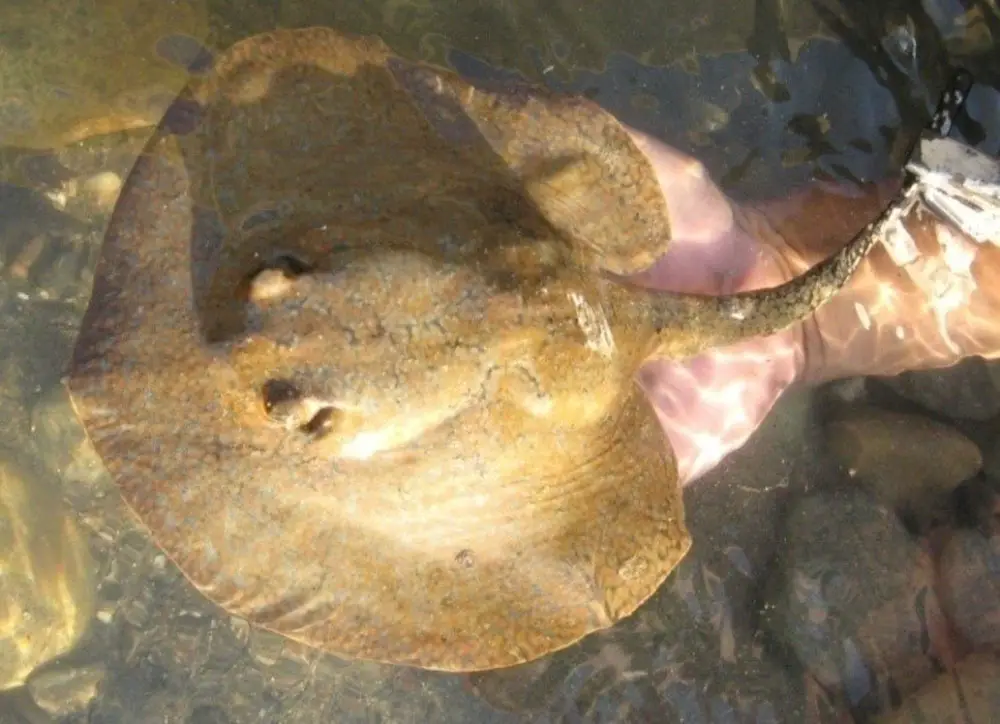
The teacup stingray, also known as reticulated stingray, is the smallest species of freshwater stingray with a typical disc width of about 8 inches (20cm) when mature (2-3 years), while some specimens can reach up to 14 inches(35 cm), not including the tail.
Tank size is the most important consideration for this species since they do not do well in small aquariums.
Because of their long whiplike tails that can easily reach the length of the body, a 125-gallon aquarium (72″ x 18″ x 21″) is the minimum size recommended for a single teacup stingray. If you want to keep a pair of teacup stingray, you will need a 180-gallon (72″ x 24″ x 25″) or larger.
Porcupine river stingray (Potamotrygon histrix)
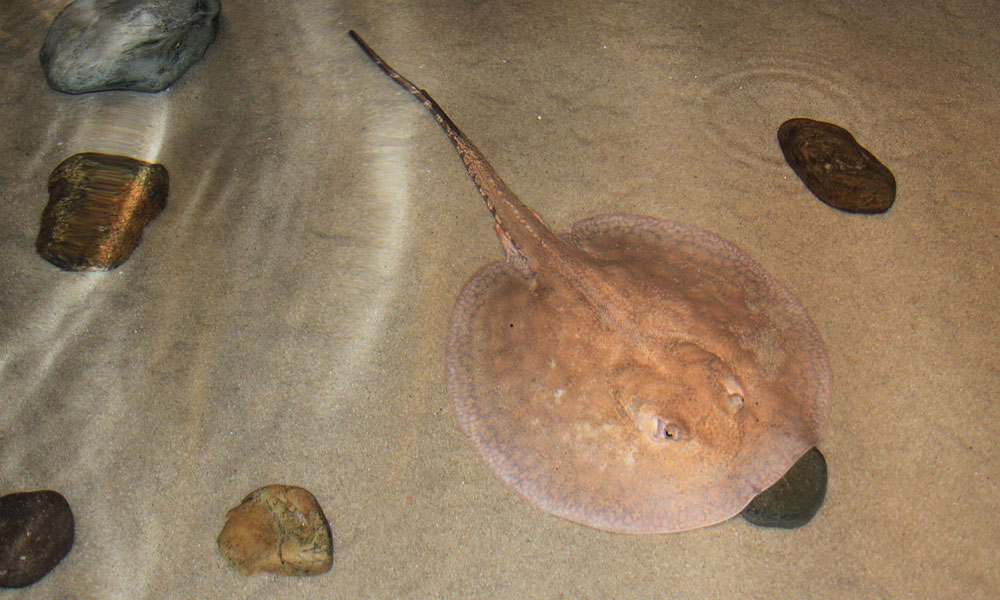
The porcupine river stingray, scientifically known as Potamotrygon histrix (sometimes misspelled with Potamotrygon hystrix), is native to Paraná and Paraguay River basins in South America.
The body is almost circular with a light brownish. The ventral is a bit pink, but not by much. There are mottled patterns that scatter all over their back.
This medium-sized species can reach a typical disc width of about 16 inches (40 cm) when mature. However, some reports of this species can reach up to 20 inches (50 cm). Plus their tails, you’ll need at least a 180-gallon tank (72″ x 24″ x 24″) for a single adult Porcupine river stingray.
If you plan on keeping a pair or group in the same tank, you’ll need more space.
Raspy river stingray (Potamotrygon scobina)
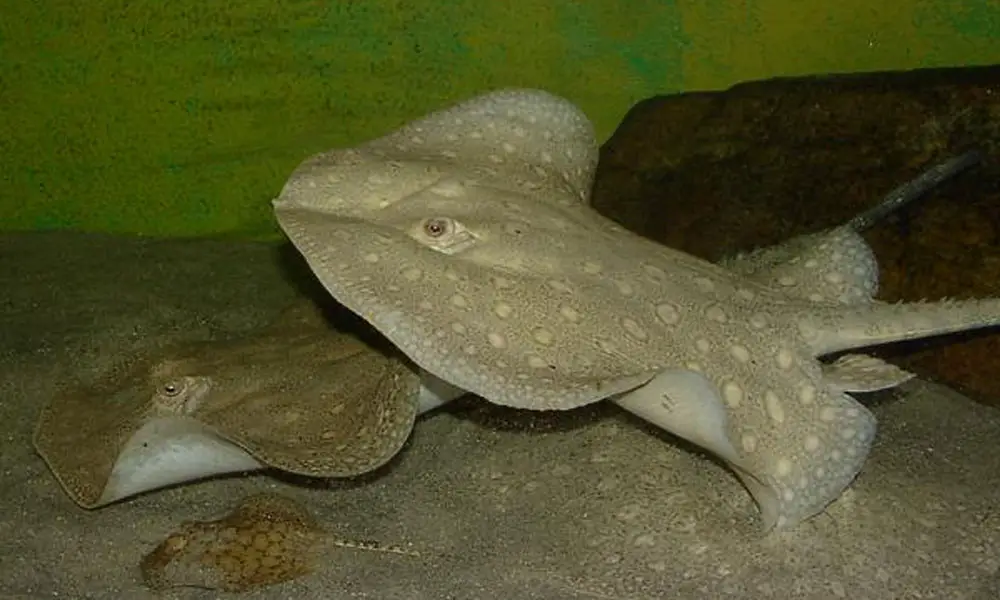
The last most votes smallest freshwater stingray on the list is Potamotrygon scobina. This ray is endemic to the lower to middle Amazon River, lower Pará River, and Trombetas River in Brazil. It’s often referred to as mosaic stingray or arraia among hobbyists.
The body shape of this species is very similar to that of Potamotrygon histrix, but the overall coloration is different. The background coloration of the mosaic stingray is light brown with beautiful mosaic white spots consisting of black on its dorsal (upper) side. The ventral (under) side is mostly white with small dark spots.
There are several geographic variants available, the disc width ranging from 10″ to 20″ (25 – 50 cm), depending on the locality. But, most captive specimens tend to stay below 14″ (35cm).
You’ll need at least a 125-gallon aquarium (72″ x 18″ x 21″) for a single adult mosaic stingray. If you plan on having more than one mosaic stingray in your tank, you may need upwards of 180 gallons (72″ x 24″ x 24″).
So, there you have it, the three most popular and obtainable freshwater stingrays that can be kept in home aquariums. There are many other smaller species that either get much larger or can’t find in the aquarium trade.
I have attached a Potamotrygon species size chart at the bottom of this article for your reference.
Freshwater Stingray Basic Care
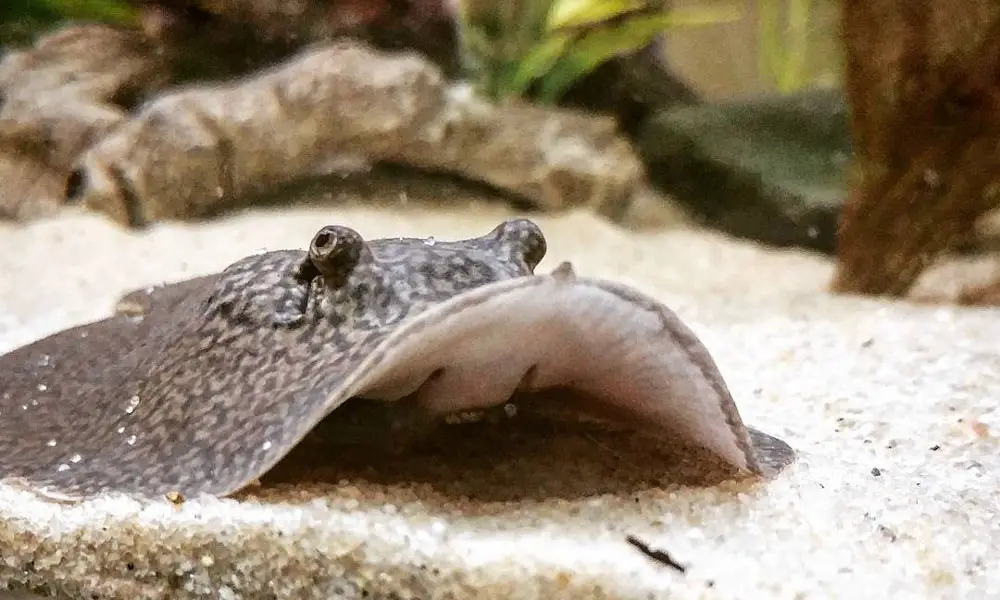
While these freshwater stingrays are definitely not beginner-friendly fish for obvious reasons, they are a fascinating addition to any experienced aquarium owner’s collection.
If you still consider yourself a beginner, I would recommend you to look into some other freshwater fish species that are a bit more forgiving and easier to care for before taking on the challenge of stingrays.
If you have your heart set on owning a stingray, let’s go over some basic guidelines for caring for these amazing creatures.
Tank Size
As is the case with sharks, stingrays are cartilaginous fish, and they don’t have a gas bladder that is found in many bony fishes – so they need to constantly swim to be able to breathe. This means that they require a lot of open space, so a larger tank is a must.
The ideal tank size depends on the species, age, and size. We have already gone over the minimum tank size requirements for each of the three most popular species.
Here is a quick recap:
| Species | Size | Tank Size (gallons) |
|---|---|---|
| Teacup Stingray (Potamotrygon magdalenae) | 8 inches (20cm) | 125g (72″ x 18″ x 21″) |
| Porcupine river stingray (Potamotrygon histrix) | 16 inches (40cm) | 180g (72″ x 24″ x 24″) |
| Raspy river stingray (Potamotrygon scobina) | 14 inches (35cm) | 125g (72″ x 18″ x 21″) |
Water Parameters
Another important factor to consider is the water quality. Stingrays are very sensitive to water parameters and need pristine water quality.
When you try to create the perfect habitat for your stingrays, you should aim to recreate their natural habitat in your aquarium.
Since they are native to the rivers of South America, they prefer warmer, soft, relatively neutral water.
Here are the recommended water parameters for freshwater stingrays:
- Water temperature: 75° – 86° F (24° – 30° C)
- pH levels: 6.0 – 7.0
- Water hardness: 4 – 10°H
- Ammonia: 0 ppm
- Nitrite: 0 ppm
- Nitrate:<30 ppm
Having a well-cycled large biofilter is crucial as freshwater stingrays are very sensitive to nitrite (NO2). They can experience a loss of appetite if the nitrite level exceeds 0.025 ppm. Any spike in nitrite levels can kill them without any warning.
Additionally, juvenile stingrays can’t survive in waters with a salinity level above 20.6%.
So, performing weekly water changes of about 30% – 50% of the tank volume and checking the water parameters consistently are the best way to prevent anything from going wrong.
I recommend investing in a solid aquarium testing kit to help you get accurate readings of your water parameters. Some serious damage occurs when ammonia or nitrite levels are not kept in check, so it’s important to catch these things early.
[amazon box=”B000255NCI”]Substrate and Decorations
In their natural habitat, stingrays spend most of their time partially buried in the sandy bottom in the marshy zones. So, a thick sandy substrate (pool filter sand should be avoided) is preferred for these bottom dwellers, in which they bury themselves, leaving only their eyes visible.
As for decorations, you can use large live plants, bogwood, or smooth rocks to add a more natural look. Just make sure they are secured to the sides and back of the aquarium so that there is a lot of open bottom space.
In addition, you should avoid using anything with sharp edges as stingrays can easily injure themselves on these objects.
Food and Diet
Freshwater stingrays are carnivorous bottom-feeders.
In the wild, they primarily feed on other small fish and invertebrates, such as worms and crustaceans.
In captivity, they should be fed a variety of live or frozen foods such as earthworms, mussels, shrimp, cockles, nightcrawlers, and squid. You can also supplement their diet with an occasional snack of healthy feeder fish.
Juveniles or several species have relatively small mouths, so you might need to chop up their food into small pieces or feed correspondingly small foods, such as bloodworm, Tubifex, or krill.
Stingrays have a good appetite and can be easily overfed. I recommend feeding the adults once daily and juveniles 1-2 times per day.
For new stingrays, you need to feed them live food such as nightcrawlers or fresh dead fish. Sometimes, it may take weeks when trying to get them to eat something new.
Patience is the key.
Freshwater Stingray Tank Mates
Despite their menacing appearance, stingrays are relatively peaceful fish.
They can be kept with other peaceful community fish species occupying the middle or top level of the tank. Of course, they should share the same water conditions as stingrays.
Avoid small fish as they can be potential meals for your stingrays, as well as Plecostomus or other suckermouth catfish that might suck on their bodies.
Some possible tank mates for small freshwater stingrays are:
- Red Shoulder Severum (Rotkeil Severum)
- Geophagus Brasiliensis (Pearl Cichlid)
- Geophagus altifron
- Geophagus sveni (Sven’s Eartheater Cichlid)
- Silver Dollar Fish (Metynnis argenteus)
- Chocolate Cichlid (Hypselecara temporalis)
- Keyhole Cichlid (Cleithracara maronii)
- Bichirs
- Other Stingrays
Freshwater Stingray Breeding
Breeding freshwater stingray is achievable in the home aquarium, but it is quite difficult.
To increase the chance of success, you need patience and a well-maintained tank with the optimal water parameters.
Freshwater stingray reproduces by matrotrophic viviparity. According to FishBase, matrotrophic viviparity means:
Internal fertilization of eggs with the mother provides some nutrition to developing embryos and with the young born as larvae.
Definition of Term – matrotrophic viviparity
Female stingrays are typically larger than males and develop two uteri, meaning they can spawn with two different males at the same time. The young (often referred to as “pups”) develop inside the uteri and are born alive.
As I mentioned before, breeding freshwater stingrays is not an easy task. If you intend to breed them, I recommend doing thorough research on the specific species you want to breed and consulting with an experienced breeder.
Here are two freshwater stingray breeding guides that might be helpful for you:
Buying The Smallest Freshwater Stingray
Since 2017, some states in the US have banned the ownership of Potamotrygon species, including:
- Arizona
- Arkansas
- California
- Georgia
- Hawaii
- Mississippi
- Nevada
- Oklahoma,
- Texas
- Utah
For people who live in the states of Colorado and Florida, you must obtain permits to own them.
Double-check with your state’s fish and wildlife department to see if it is legal for you to own a freshwater stingray.
Potamotrygon Species Size Chart
| Potamotrygon sp | Max Length (not including tails) |
|---|---|
| Potamotrygon marinae | 20″ (50.8 cm) |
| Potamotrygon tigrina | 19″ (48 cm) |
| Potamotrygon leopoldi | 16″ (40 cm) |
| Potamotrygon falkneri | 18.8″ (47 cm) |
| Potamotrygon orbignyi | 15″(38.1 cm) |
| Potamotrygon ocellata | 8″ (20 cm) |
| Potamotrygon adamastor | 21″ (54.5 cm) |
| Potamotrygon amandae | 12″ (31.2 cm) |
| Potamotrygon amazona | 23″ (58.4 cm) |
| Potamotrygon boesemani | 16″ (41.3 cm) |
| Potamotrygon brachyura | 37″ (95.0 cm) |
| Potamotrygon constellata | 24″ (62.0 cm) |
| Potamotrygon garmani | 16.8″ (42.8 cm) |
| Potamotrygon henlei | 23.6″ (60 cm) |
| Potamotrygon limai | 25.5″ (64.8 cm) |
| Potamotrygon motoro | 19.7″ (50.0 cm) |
| Potamotrygon pantanensis | 10.6″ (26.8 cm) |
| Potamotrygon rex | 29.5″ (75.0 cm) |
| Potamotrygon schroederi | 23.6″ (60 cm) |
| Potamotrygon signata | 11.8″ (30.0 cm) |
| Potamotrygon tatianae | 14.2″ (36.2 cm) |
| Potamotrygon wallacei | 12.2″ (31.0 cm) |
| Potamotrygon yepezi | 15.7″ (40.0 cm) |
Wrap Up
I hope that this article has helped to clear some things up and that you feel more prepared to take on the challenge of keeping a freshwater stingray in your home aquarium.
As always, if you have any feedback that would help to make this article more informative or helpful, please don’t hesitate to reach out to us.
